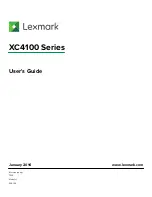
CS240
7-7
Appendix
7
7.3
Glossary
Term
Definition
10Base-T/100Base-
TX/1000Base-T
An Ethernet standard, which is a cable consisting of twisted copper wire pairs. The
transmission speed of 10Base-T is 10 Mbps, of 100Base-TX is 100 Mbps, and of
1000Base-T is 1000 Mbps.
Active directory
A service that manages all information such as hardware resources for servers, cli-
ents, and printers on a network supported by Microsoft and the attributes and ac-
cess permissions of the users
Adobe
®
Flash
®
Software developed by Adobe Systems Incorporated (formerly Macromedia, Inc.)
and used to create data combining vector-graphic animation and sound, and the for-
mat of this data file. The bidirectional content can be manipulated using a keyboard
and a mouse. The files can be kept relatively compact, and they can be accessed
with the Web browser plug-in.
anonymous FTP
While normal FTP sites are protected by an account name and password, this type
of FTP site can be used by anyone without a password by simply entering "anony-
mous" as the account name.
APOP
Abbreviation for Authenticated Post Office Protocol. An authentication method with
encrypted passwords, which results in increased safety, as compared to the usual
unencrypted passwords used by POP to retrieve e-mail messages
AppleTalk
A generic name for the protocol suite developed by Apple Computer for computer
networking
Auto IP
A function for automatically acquiring the IP address. If acquisition of the IP address
failed with DHCP, an IP address is acquired from the address space of 169.254.0.0.
bit
Abbreviation for Binary Digit. The smallest unit of information (data quantity) on a
computer or printer. Displays data using 0 or 1.
BMP
Abbreviation for Bitmap. A file format for saving image data which uses the .bmp ex-
tension. Commonly used on Windows platforms. You can specify the color depth
from monochrome (2 values) to full color (16,777,216 colors). Images are not usually
compressed when saved.
Bonjour
Macintosh network technology for automatically detecting devices connected to the
network and for specifying settings. Previously called "Rendezvous", the name was
changed to "Bonjour" starting with Mac OS X v10.4.
Byte
Unit of information (data quantity) on a computer or printer. Configured as 1 byte
equals 8 bits.
Client
A computer that uses the services provided by a server through a network
Compact PDF
Compression method for reducing the data amount using the PDF format when con-
verting color documents to data.
The highest compression efficiency is achieved by identifying the text and image re-
gions and using the resolution and compression method most appropriate for each
region.
The compact PDF format can be selected when converting documents to data using
the scanning functions of this machine.
Contrast
The difference in intensity between the light and dark parts of the image (light/dark
variation). An image with little light/dark variation is said to have a low contrast, and
an image with large light/dark variation is said to have a high contrast.
CSV
Abbreviation for Comma Separated Values. One of the formats for saving database
or spreadsheet data as a text file. (The file extension is ".csv".) The data, which is
separated by commas (as the delimiter), can be shared by different applications.
Default
The initial settings. The settings first selected when the machine is turned on, or the
settings first specified when the function is selected.
Default gateway
A device, such as a computer or router, used as a "gateway" to access computers
not on the same LAN.
Density
An indication of the amount of darkness in the image.
DHCP
Abbreviation for Dynamic Host Configuration Protocol. A protocol in which a client
computer on a TCP/IP network automatically specifies the network settings from the
server. With collective management of the IP address for DHCP clients on the DHCP
server, you can avoid duplication of an address and you can build a network easily.
DNS
Abbreviation for Domain Name System. A system that acquires the supported IP ad-
dresses from host names in a network environment. DNS allows the user to access
other computers over a network by specifying host names, instead of difficult to
memorize and understand IP addresses.
Summary of Contents for Linium PRO C6500
Page 1: ...Océ CS240 User Manual Network scanner operations ...
Page 2: ......
Page 8: ...Contents 6 CS240 ...
Page 9: ...1 Introduction ...
Page 10: ......
Page 19: ...2 Before using scanning functions ...
Page 20: ......
Page 29: ...3 Scanning ...
Page 30: ......
Page 105: ...4 Specifying utility mode parameters ...
Page 106: ......
Page 155: ...5 Network settings ...
Page 156: ......
Page 256: ...5 Network settings 5 102 CS240 ...
Page 257: ...6 Scan function troubleshooting ...
Page 258: ......
Page 260: ...6 Scan function troubleshooting 6 4 CS240 ...
Page 261: ...7 Appendix ...
Page 262: ......
Page 272: ...7 Appendix 7 12 CS240 ...
Page 273: ...8 Index ...
Page 274: ......










































